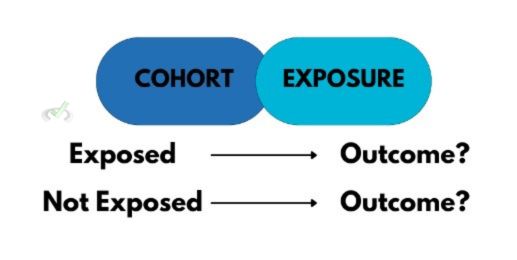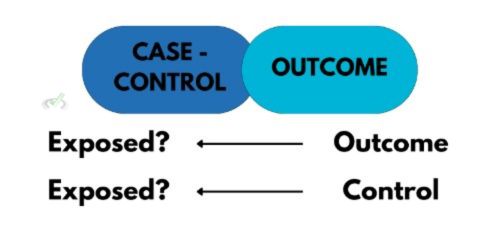Cohort and case-control studies are both types of observational research. They help researchers understand relationships between factors and outcomes. This guide will cover what these studies are, their key parts, and how they are used.
I. Introduction to Cohort and Case-Control Studies
Cohort and case-control studies are important in research. They help us find out what factors might cause a condition or disease. Understanding these studies helps us choose the right method for our research questions.
A. Observational Studies: Watching and Learning

Observational studies involve watching and recording behaviors or events without changing anything. Both cohort and case-control studies fall into this category. They help us understand links between exposures (things that might cause something) and outcomes (the results or conditions).
II. Cohort Studies: Tracking Over Time
Cohort studies follow a group of people over time and examine how certain factors affect outcomes. They can be prospective (looking forward) or retrospective (looking back).

A. Prospective Cohort Studies: Looking Forward
Prospective cohort studies start with a group of people who do not have the condition being studied. Researchers follow them over time to see who develops the condition. For example, they might follow a group of smokers and non-smokers to see who gets lung cancer.
B. Retrospective Cohort Studies: Looking Back
Retrospective cohort studies look at existing records to find a group of people exposed to certain factors in the past. Then, they look at who developed the condition. For example, researchers might look at past medical records to study the long-term effects of a medication.
C. Key Parts of Cohort Studies
Cohort studies have several important parts:
- Exposure: The factor being studied, like smoking.
- Outcome: The condition or disease being studied, like lung cancer.
- Follow-Up: The period over which the participants are observed. The longer the follow-up, the more accurate the results.
D. Strengths and Weaknesses of Cohort Studies
Cohort studies have strengths and weaknesses:
Strengths:
- Can study multiple outcomes from a single exposure.
- Good for studying rare exposures.
Weaknesses:
- It can be expensive and time-consuming.
- Not good for studying rare diseases.
III. Case-Control Studies: Comparing Groups
Case-control studies compare people with a specific condition (cases) to those without it (controls). They help identify factors that might contribute to the condition.

A. How Case-Control Studies Work
Researchers start with two groups: one with the condition and one without. They look back to see what factors might have caused the condition. For example, they might compare people with diabetes (cases) to those without it (controls) to find lifestyle factors involved.
B. Key Parts of Case-Control Studies
Case-control studies have several important parts:
- Cases: People with the condition being studied.
- Controls: People without the condition.
- Exposure: The factors being studied that might cause the condition. Researchers compare how often the exposure occurred in each group.
C. Strengths and Weaknesses of Case-Control Studies
Case-control studies have strengths and weaknesses:
Strengths:
- Good for studying rare diseases.
- Less expensive and faster than cohort studies.
Weaknesses:
- Can only study one outcome.
- Prone to recall bias (participants may not remember past exposures accurately).
IV. Comparing Cohort and Case-Control Studies
Both types of studies have their uses. Understanding their differences helps researchers choose the best method for their questions.
A. Time Frame
- Cohort Studies: Follow participants over time.
- Case-Control Studies: Look back at past exposures.
B. Cost and Time
- Cohort Studies: More expensive and time-consuming.
- Case-Control Studies: Less expensive and quicker.
C. Suitable Conditions
- Cohort Studies: Better for studying multiple outcomes from one exposure.
- Case-Control Studies: Better for studying rare diseases.
V. Bridge/Overlap
Cohort and case-control studies are not just for understanding diseases. They connect to broader fields and have real-world implications.
A. Ethical Considerations in Observational Studies
Ethical considerations are crucial in all types of research studies. Researchers must ensure the safety and privacy of participants. They need informed consent, meaning participants agree to participate after being told about the study's purpose and risks. Researchers must also avoid bias and report findings honestly to ensure trust in their results.
B. The Role of Technology in Observational Studies
Technology helps researchers collect and analyze data. Computers can quickly analyze large datasets to find patterns. Tools like electronic health records make retrospective studies easier. Statistical software helps in analyzing the data accurately.
C. Impact on Public Health and Policy
Research findings often inform health policies. Studies on smoking and lung cancer led to public health campaigns against smoking. Understanding the factors behind diseases helps in making better health guidelines. For example, research on the spread of infectious diseases guides vaccination programs.
D. Connection to MCAT Topics
These studies are linked to many topics covered on the MCAT, such as statistics, the scientific method, and psychological research methods. Understanding these studies helps in interpreting scientific literature and applying critical thinking skills. For example, knowing about confounding variables (outside factors that might affect the results) is crucial when evaluating the validity of a study's findings.
VI. Wrap Up/Key Terms
Understanding cohort and case-control studies is key for interpreting research. Each type has its strengths and limitations.
Key Terms
- Cohort Studies: Follow a group to see how factors affect outcomes.
- Prospective: Looking forward.
- Retrospective: Looking back.
- Case-Control Studies: Compare people with and without a condition to find causes.
- Cases: People with the condition.
- Controls: People without the condition.
- Exposure: The factors being studied.
- Recall Bias: Inaccuracy in remembering past exposures.
- Confounding Variables: Outside factors that might affect the results.
VII. Practice Questions
Test your understanding with these questions:
Sample Practice Question 1
Which type of study follows a group of people over time to see how certain factors affect outcomes?
A. Case-Control Study
B. Cohort Study
C. Cross-Sectional Study
D. Randomized Controlled Trial
Ans. B
Cohort studies follow people over time. They look at how different factors affect outcomes, making them the best type for this purpose.
Sample Practice Question 2
What is a major weakness of case-control studies?
A. They are expensive and time-consuming.
B. They are prone to recall bias.
C. They cannot study rare diseases.
D. They require a large sample size.
Ans. B
Case-control studies can be affected by recall bias. This happens when participants do not remember their past exposures accurately. This can affect the study's results.







 To help you achieve your goal MCAT score, we take turns hosting these
To help you achieve your goal MCAT score, we take turns hosting these 





















 reviews on TrustPilot
reviews on TrustPilot